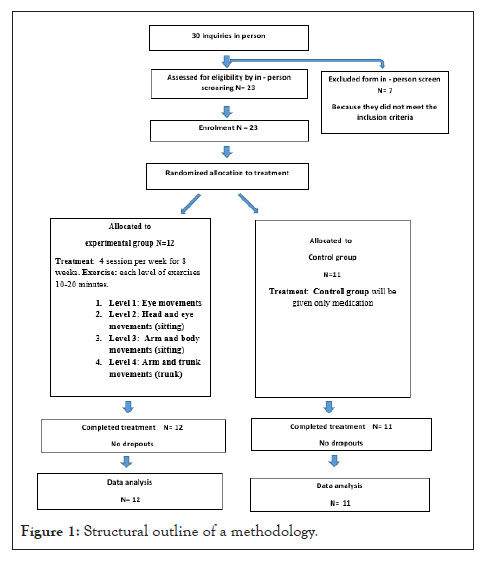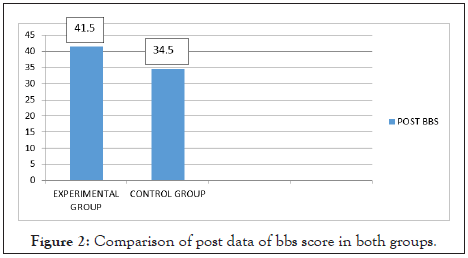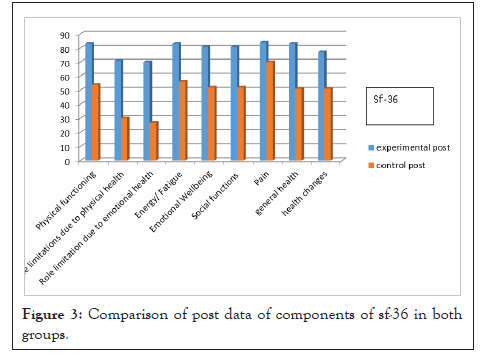International Journal of Physical Medicine & Rehabilitation
Open Access
ISSN: 2329-9096
ISSN: 2329-9096
Research Article - (2020)Volume 8, Issue 6
The purpose of the study was to identify the effect of Specific Cawthorne and Cooksey exercises in 60-70-year-old individuals for reduction in the frequency of falls in the specific age group. To observe the effect of the specific exercises on balance and fear of fall, a group of 23 patients (12 in interventional and 11 in control group), age group between 60-70 years old was taken. In conclusion, the Interventional group suggested improvement of balance according to the Berg Balance Scale with the score of mean 41.5 and the control group (was not given any therapeutic intervention) the BBS mean score was 34.5. The result was thus indicative of positive effect of Cawthorne and Cooksey exercises on reduction of frequency of fall and imbalance in the older age group.
Fall; Balance; Cawthorne; Cooksey exercises; Berg balance scale
Aging is a process through which slow, spontaneous and progressive changes occur in the body structure over time and affect human life [1]. Indian population census in 2011 estimated that there are nearly 104 million elderly people which are expected to grow to 173 million by 2026 due to the current advancement in the medical field leading to increased average life expectancy [1].
Among many other issues, functional independent problems are more important. Balance is defined as the ability to maintain a condition for voluntary activities and coping with protuberances (internal and external), and in biomechanical aspect, maintaining Body of Mass (BOM) in Base of Support (BOS) area [2]. With onset of aging, metabolic and physiologic changes which may affect musculoskeletal, vestibular, somatosensory and visual systems and the ability of elders to maintain balance, putting them at risk of injuries, such as falls, fractures and long disabilities. These negative changes threat quality of life of elderly and prevent them to perform their activities of daily living [3].
Quality of life has become one of the most important contemporary issues in healthcare. Decline of balance in the elderly would increase their risk of fall. As falls can affect performance and independence, identifying those at risk of falls and developing diagnostic and treatment methods can improve Quality of life and independence and also reduces health care costs [4].
Vestibular exercises, such as the ones described by Cawthorne and Cooksey, may serve as support for new arrangements of peripheral sensorial information, allowing new vestibular stimulation pattern necessary for new experiences to become automatic. CCE is the most common protocol for vestibular rehabilitation program, which involves balance centers such as visual, proprioceptive and vestibular activities. Also, CCE can be used to enhance the formation of new environmental sensory information and it has ability to improve balance responses and thus reduce falls [5].
Purpose of this exercise is to build up a tolerance mechanism and the more diligently and regularly they are carried out, the sooner the symptoms will disappear [6].
Medication may have been prescribed to ease the symptoms should be continued while being on this programme [7].
Thus, it is expected from the study to be performed, that by this intervention, the balance and quality of life of elders will improve. Therefore, this study will be conducted to investigate the effect of CCE on balance and quality of life of 60-70-year-old individuals living in Anand. Conclusion will be driven by assessing which group is taken off the medication faster and thus which group gains improved balance and quality of life faster.
The Cawthorne and Cooksey exercises may serve as support for new arrangements of peripheral sensorial information, allowing new vestibular stimulation patterns necessary for new experiences to become automatic [8]. This practice of balance would be capable of promoting improvement in reactions of balance and, consequently, reduce falls. The use of soft surface to reduce proprioceptive input, and exercises with closed eyes to exclude visual cues.
Need of the study
The main need of the study focuses on;
1. How much Affection of vestibular System can lead to balance dysfunction in older age population and the extent to which it can be treated by physical therapy.
2. The reduction in fall frequency by the given set of exercises and their connection to changes in the quality of life before and after the intervention.
Procedure
Sample size: 30 individuals were screened with marked vestibular dysfunction and hypo function. A written consent was taken from the individuals who fulfilled the inclusion criteria of the study [9-11] (Table 1).
| Inclusion criteria | Exclusion criteria |
|---|---|
| 1. MMSE questionnaire score higher than 21 | 1. Unwillingness to participate in the experiment |
| 2. Evident history and complain of imbalance and disequilibrium. | 2. Incidence of stroke during the study. |
| 3. Age group of 60-70 year. | 3. Age greater than 70 years old and less than 60-year-old. |
| 4. No significant history of psychiatric, orthopaedic, cardio respiratory or rheumatologic disorder. | 4. Having any other major co-morbidity. |
| 5. Acute cases with complains of balance and disequilibrium | 5. Patient with severe musculoskeletal, cardiac or psychological conditions. |
| 6. Medication prescribed by the medical professionals will be continued in the duration of the intervention. | |
| 7. Patient complaining of both central and peripheral causes leading imbalance and disequilibrium. |
Table 1: Inclusion and exclusion criteria for the workflow opted.
The subjects were divided into 2 groups by convenient sampling (12 in interventional group and 11 in control group). Other than the 23 individuals who took part in the study, other 7 were excluded due to the given exclusion criteria [12] (Figure 1).

Figure 1: Structural outline of a methodology.
Control group were given education to reduce fear of fall and medication and pre and post scoring were recorded [13].
Intervention group were given Cawthorne and Cooksey exercises for a 2-month duration and the scoring was recorded.
According to the level of dizziness and the positions in which they were given, the average duration/dosage level of a level of exercise in 10-20 minutes [14].
• Symptom free
• Mild discomfort
• Moderate level of discomfort
• Severe level of discomfort
All the subjects were assessed by using Berg balance scale to assess the balance reliability of 0.93-0.95 and Quality of life questionnaire to assess the quality of life reliability 0.77-0.90 [15] (Table 2).
| Level 1: Eye movements | Level 2: Head and eye movements (sitting) | Level 3: Arm and body movements (sitting) | Level 4: Arm and trunk movements (trunk) |
|---|---|---|---|
| 1) Look up, down slowly at first, then rapidly 20 times. | 1) Bend head forwards and backwards (eye open). First slowly, then quickly | 1) Shrug shoulder- 20 times | 1) Repeat all the level 3 |
| 2) Continue as above, add side to side movements | 2) Including the above, add left and right head movements. | 2) Circle shoulder-20 times | 2) Sit down and stand up 20 times with eyes open. |
| 3) Focus on finger at arm’s length. Maintain focus while moving finger towards nose and away again 20 times | 3) Repeat both the above exercises, but with eyes closed. | 3) Rotate to the right and then to the left, at waist (i.e. upper part of the body moves together) 20 times | 3) Sit down and stand up 20 times with eyes closed. |
| 4) Turn head side to side through full range in rotation, but slowly. | |||
| 5) Repeat the upper exercise doing two slow turns following one rapid turn. | |||
| 6) Repeat the above exercise. After a couple of seconds pause, repeat with 3 rapid turns. | |||
| 7) Repeat above exercises, but with eyes closed. |
Notes- 1) other alterations of these exercises are also there which can be prescribed likewise
2) These levels are to be performed as the above level shows reduction in giddiness in ascending order
Table 2: Level of exercises to be performed
Data analysis
Paired t-test was used to compare significance difference in outcome measurement before and after the intervention. Unpaired t-test was used to compare significance difference in outcome measure between the groups.
Each calculated t-value was compared to t-table value to test hypothesis at 0.05 (5%) level of significance.
All the descriptive data was analyzed to see homogeneity of 2 groups for all the possible confounding factors. Total 23 patients were taken so according to each variables distribution and difference is seen (Table 3).
| Characteristics | Group-A (Experimental Group) | Group-B (Control Group) | t-value | P value |
|---|---|---|---|---|
| Total Number of Patients | 12 | 11 | ||
| Age (mean ± SD) Year | 65.16 ± 3.80 | 66.45 ± 2.69 | ||
| Male | 5 | 4 | 0.058 | 0.9745 |
| Female | 7 | 7 | ||
| POMA (mean ± SD) | 17.66 ± 4.45 | 15.27 ± 3.79 |
Table 3: Baseline criteria.
As shown in Table 4, there was increase in BBS score in the both group after 2 months but more improvement is seen in the experimental group than the control group. The mean of BBS score in experimental group after the intervention was 41.5 and in control group was 34.54 with the SD of 8.67 and 3.26 respectively with p value of 2.499 and df 21 (p<0.05=significant) (Figure 2).
| Outcome measure | Groups | Mean | SD | Unpaired t value | P value | Df |
|---|---|---|---|---|---|---|
| Berg balance scale | Experimental post | 41.5 | 8.67075 | |||
| Control post | 34.5455 | 3.26691 | 2.499 | 0.0208 | 21 |
Table 4: Comparisons of post data of bbs score in experimental and control group.

Figure 2: Comparison of post data of bbs score in both groups.
As shown in Table 5, the mean of sf-36 score changed after the intervention in both the group but more marked change was observed in the experimental group as compare to control group. The mean and SD of physical functioning component in exp. Group was 83 ± 0.078 and in control group was 54 ± 0.18. The mean and SD of role limitation due to physical health component in exp. Group was 71 ± 0.25 and in control group was 30 ± 0.18. The mean and SD of role limitation due to emotional health component in exp. Group was 70 ± 0.17 and in control group was 27 ± 0.25. The mean and SD of Energy/Fatigue component in exp. Group was 83 ± 0.109 and in control group was 56 ± 0.170. The mean and SD of emotional wellbeing component in exp. Group was 81 ± 0.11 and in control group was 52 ± 0.16. The mean and SD of social functions component in exp. Group was 81 ± 0.13 and in control group was 52 ± 0.23. The mean and SD of pain component in exp. Group was 84 ± 0.12 and in control group was 70 ± 0.25. The mean and SD of general health component in exp. Group was 83 ± 0.09 and in control group was 51 ± 0.25. The mean and SD of health changes component in exp. Group was 77 ± 0.22 and in control group was 51 ± 0.31 (Figure 3).
| Components of SF-36 | Exp post (Mean%) | Cont post (Mean%) | Exp post (SD) | Cont post (SD) | P value | t value | df |
|---|---|---|---|---|---|---|---|
| Physical functioning | 83 | 54 | 0.07834 | 0.18178 | <0.0001 | 5.023 | 21 |
| Role limitations due to physical health | 71 | 30 | 0.25746 | 0.18769 | 0.0003 | 4.359 | 21 |
| Role limitation due to emotional health | 70 | 27 | 0.17185 | 0.25091 | 0.0001 | 4.774 | 21 |
| Energy/Fatigue | 83 | 56 | 0.10975 | 0.17043 | 0.0002 | 4.412 | 21 |
| Emotional Wellbeing | 81 | 52 | 0.11836 | 0.16729 | <0.0001 | 4.824 | 21 |
| Social functions | 81 | 52 | 0.13635 | 0.23738 | 0.0021 | 3.513 | 21 |
| Pain | 84 | 70 | 0.12616 | 0.25045 | 0.1037 | 1.701 | 21 |
| General health | 83 | 51 | 0.09886 | 0.25477 | 0.0007 | 3.987 | 21 |
| Health changes | 77 | 51 | 0.22508 | 0.31945 | 0.0355 | 2.248 | 21 |
Table 5: Comparison of post data of components of sf-36 in both groups

Figure 3: Comparison of post data of components of sf-36 in both groups.
The Experimental study was conducted to compare the effect of Cawthorne and Cooksey exercises on individuals falling in the age group of 60-70 years which have complains of imbalance and increased frequency of falls which directly related to reduction in the quality of their living. Both the groups are homogeneous and the subjects were comparable in terms of studied variable.
The observed changes in the Berg Balance Score revealed that Cawthorne and Cooksey exercises can improve balance in the normal elderly people, aged 60-70 years of age. The possible reason could involve that these exercises are part of a vestibular rehabilitation program and involve head, neck and eye movements, posture control exercises in different positions (seated, in two-leg and one-leg positions, walking), use of soft surface to reduce proprioceptive input, and exercises with closed eyes to exclude visual cues [12]. Even these exercises combine head movements while fixating a target to produce retinal slip. The Central Nervous System then, attempts to reduce this error signal by modifying the gain of vestibular system, that is, through adaptation of the vestibular system. Adaptation is modification of the gain of the relevant vestibulo-occulomotor and vestibulospinal circuits and habituation, that is, a central process of learning which is independent of sensory adaptation and motor fatigue (Stefano. et al.,).
Considering that falls are aspects that substantially change the quality of life of the elderly and that life expectancy of the population in general has increased significantly, leading to increasingly higher elderly population every year, general therapeutic interventions directed to the elderly and especially those that provide prevention of falls owing to improvement of posture stability, will eventually lead to improvement in quality of life of elderly people.
For assessing the Quality of life of Patients, the SF-36 multi-item scale is used which is a self-administered scale [13] which also showed positive improvement in the post assessment after the intervention, especially when compared to the control group together both balance and quality of life improvement is widely seen in the study.
As for the level of significant changes seen in the study, excellent reliability of BBS of 5 points and of Quality of life of 4-5 points on the MDC95 is seen, which shows the highly significant change in the post results of the study [14].
From this we concluded that it is advisable for elder patients to undergo clinic based vestibular exercises along with home exercise program which is modified according to their own contextual factors, as our study showed significant improvement in their Balance improvement, reduction in the frequency of falls and quality of life.
• This study has been performed in small sample size.
• Lack of homogenous gender population available for the study.
• This is the short duration study.
• Lack of long-term follow-up and assessment of effect of the improvement of the exercises for longer duration cannot be known.
• The study should be done with the large sample size.
• The study should be done with long duration of intervention.
• Study should be done with Outcomes which shows direct corelation between balance and the affected Quality of life of the patient.
• Long term follow-up posts the study can be provided.
Citation: Parmar V, Bhatt K (2020) An Experimental Study on Prevention and Reduction in Fall Frequency in Elderly Population by Cawthorne and Cooksey Exercises. Int J Phys Med Rehabil. 8:573.
Received: 26-Sep-2020 Accepted: 12-Oct-2020 Published: 19-Oct-2020 , DOI: 10.35248/2329-9096.21.8.573
Copyright: © 2020 Parmar V, et al. This is an open-access article distributed under the terms of the Creative Commons Attribution License, which permits unrestricted use, distribution, and reproduction in any medium, provided the original author and source are credited.